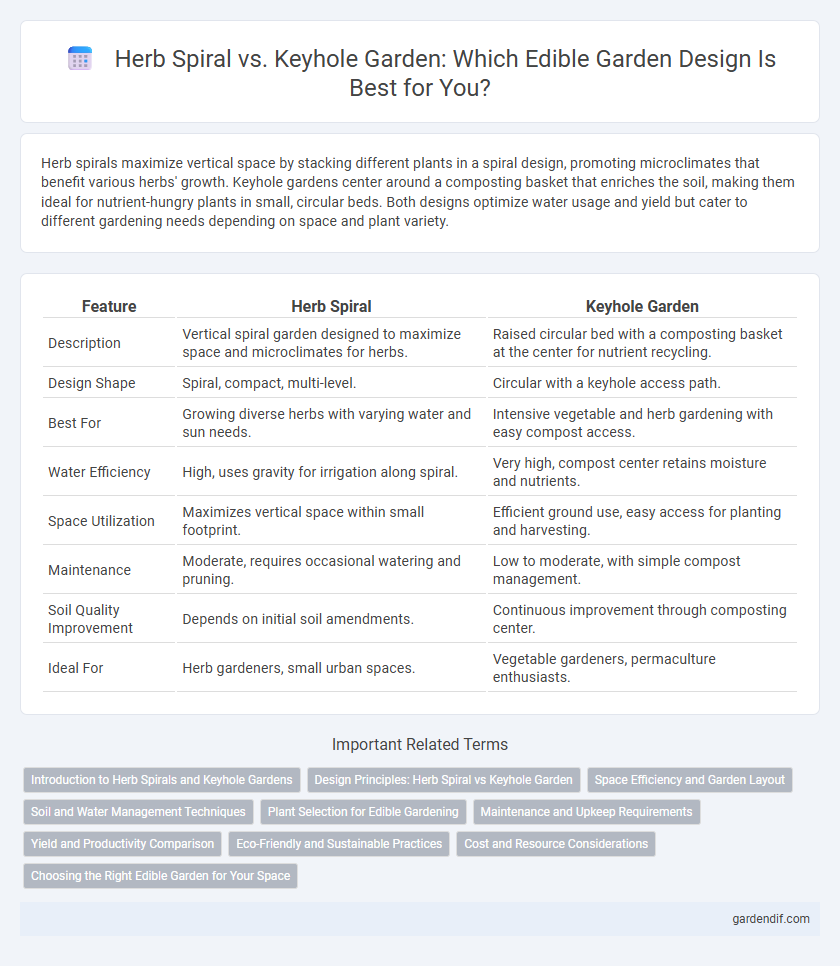
Herb Spiral vs Keyhole Garden Illustration
Herb spirals maximize vertical space by stacking different plants in a spiral design, promoting microclimates that benefit various herbs' growth. Keyhole gardens center around a composting basket that enriches the soil, making them ideal for nutrient-hungry plants in small, circular beds. Both designs optimize water usage and yield but cater to different gardening needs depending on space and plant variety.
Table of Comparison
| Feature | Herb Spiral | Keyhole Garden |
|---|---|---|
| Description | Vertical spiral garden designed to maximize space and microclimates for herbs. | Raised circular bed with a composting basket at the center for nutrient recycling. |
| Design Shape | Spiral, compact, multi-level. | Circular with a keyhole access path. |
| Best For | Growing diverse herbs with varying water and sun needs. | Intensive vegetable and herb gardening with easy compost access. |
| Water Efficiency | High, uses gravity for irrigation along spiral. | Very high, compost center retains moisture and nutrients. |
| Space Utilization | Maximizes vertical space within small footprint. | Efficient ground use, easy access for planting and harvesting. |
| Maintenance | Moderate, requires occasional watering and pruning. | Low to moderate, with simple compost management. |
| Soil Quality Improvement | Depends on initial soil amendments. | Continuous improvement through composting center. |
| Ideal For | Herb gardeners, small urban spaces. | Vegetable gardeners, permaculture enthusiasts. |
Introduction to Herb Spirals and Keyhole Gardens
Herb spirals are vertical garden structures designed to maximize space and create microclimates for diverse herbs by stacking soil layers in a spiral shape. Keyhole gardens feature a circular raised bed with a central composting basket, promoting efficient water retention and nutrient recycling in arid environments. Both designs optimize sustainable edible gardening by enhancing plant diversity and resource use efficiency.
Design Principles: Herb Spiral vs Keyhole Garden
Herb spirals emphasize vertical layering and microclimates to maximize space and moisture retention, using a spiral mound that supports diverse herb growth from sun to shade. Keyhole gardens focus on accessibility and water efficiency with a raised, circular bed and a central compost basket that nourishes plants and conserves moisture. Both designs optimize ecological principles but prioritize spatial use versus ergonomic access and nutrient cycling.
Space Efficiency and Garden Layout
Herb spirals maximize vertical space by stacking plants in ascending layers, allowing for diverse microclimates within a compact footprint ideal for small or urban gardens. Keyhole gardens feature a circular design with a central composting basket, optimizing access and efficient use of space by radiating planting beds outward. Both garden layouts enhance space efficiency but differ in structure: herb spirals emphasize vertical layering, while keyhole gardens focus on radial accessibility.
Soil and Water Management Techniques
Herb spirals utilize vertical layering to create microclimates that optimize soil nutrients and moisture retention by directing water from top to bottom, enhancing efficient water use in small spaces. Keyhole gardens incorporate a central compost basket that continuously enriches the soil with organic matter and facilitates even water distribution through a basin with a built-in drainage system, reducing water runoff and improving soil aeration. Both designs promote sustainable soil and water management by maximizing water absorption and nutrient cycling but differ in structure and water delivery methods tailored to diverse gardening needs.
Plant Selection for Edible Gardening
Herb spirals maximize vertical space, supporting diverse herb varieties such as basil, thyme, and rosemary by creating microclimates that suit a range of sun and moisture preferences. Keyhole gardens focus on nutrient-dense edible plant selection like leafy greens, root vegetables, and legumes, benefiting from a central composting basket that enriches the soil efficiently. Both designs enhance yield and biodiversity but differ in plant arrangement and water retention strategies.
Maintenance and Upkeep Requirements
Herb spirals require moderate maintenance, including regular pruning and watering to support vertical growth and diverse plant needs, while keyhole gardens are designed for low-maintenance with well-draining soil and integrated composting reducing frequent watering. Keyhole gardens benefit from their compact design that minimizes weeding and soil replenishment, whereas herb spirals demand more attention to managing microclimates and plant spacing. Both systems promote sustainable gardening but differ in their upkeep intensity due to structural and watering variations.
Yield and Productivity Comparison
Herb spirals maximize vertical space, allowing a diverse range of herbs to grow in a compact footprint, which increases overall yield per square foot compared to traditional garden beds. Keyhole gardens, designed with a central composting basket, enhance soil fertility and moisture retention, leading to higher productivity and larger yields of vegetables and herbs in nutrient-poor conditions. Both systems improve space efficiency, but the keyhole garden often produces greater biomass due to its superior soil enrichment and water conservation capabilities.
Eco-Friendly and Sustainable Practices
Herb spirals and keyhole gardens both promote eco-friendly and sustainable practices by maximizing space and conserving water through efficient design. Herb spirals create microclimates that support diverse plant life with minimal irrigation, while keyhole gardens incorporate composting zones to recycle nutrients and reduce waste. Both structures enhance soil health naturally, reducing reliance on chemical fertilizers and fostering biodiversity in edible gardening.
Cost and Resource Considerations
Herb spirals typically require fewer materials and less water due to their vertical design, making them cost-effective and resource-efficient for small-scale edible gardening. Keyhole gardens, while needing more initial soil and compost, optimize space and reduce water use through a central compost basket, balancing upfront costs with sustainable resource management. Evaluating local material availability and long-term maintenance expenses is crucial when choosing between these permaculture structures.
Choosing the Right Edible Garden for Your Space
Herb spirals maximize vertical growing space by stacking herbs in a compact, tiered design, ideal for small gardens or patios with limited footprints. Keyhole gardens offer a raised, circular bed with a central composting basket that improves soil fertility and water retention, perfect for spaces needing efficient resource use and easy access. Selecting between these designs depends on your available area, desired plant variety, and maintenance preferences to create a sustainable, productive edible garden.
Herb Spiral vs Keyhole Garden Infographic

 gardendif.com
gardendif.com